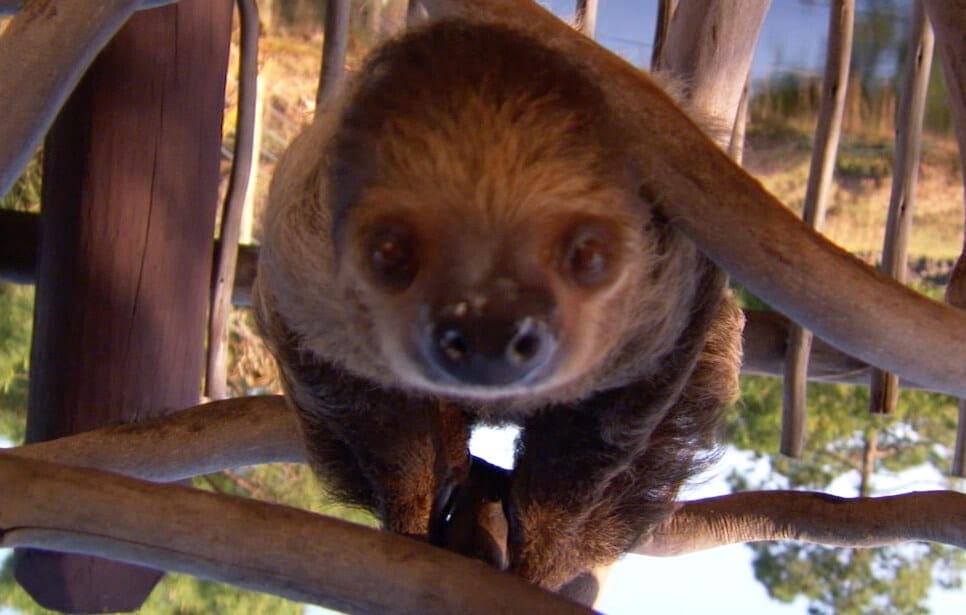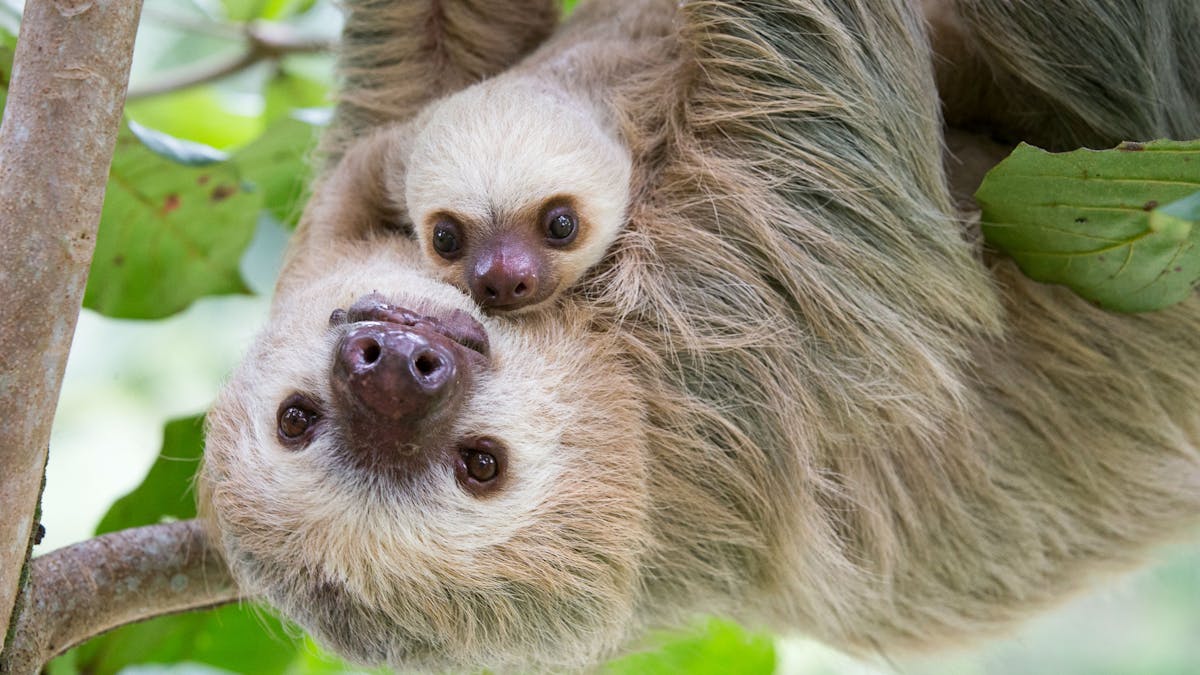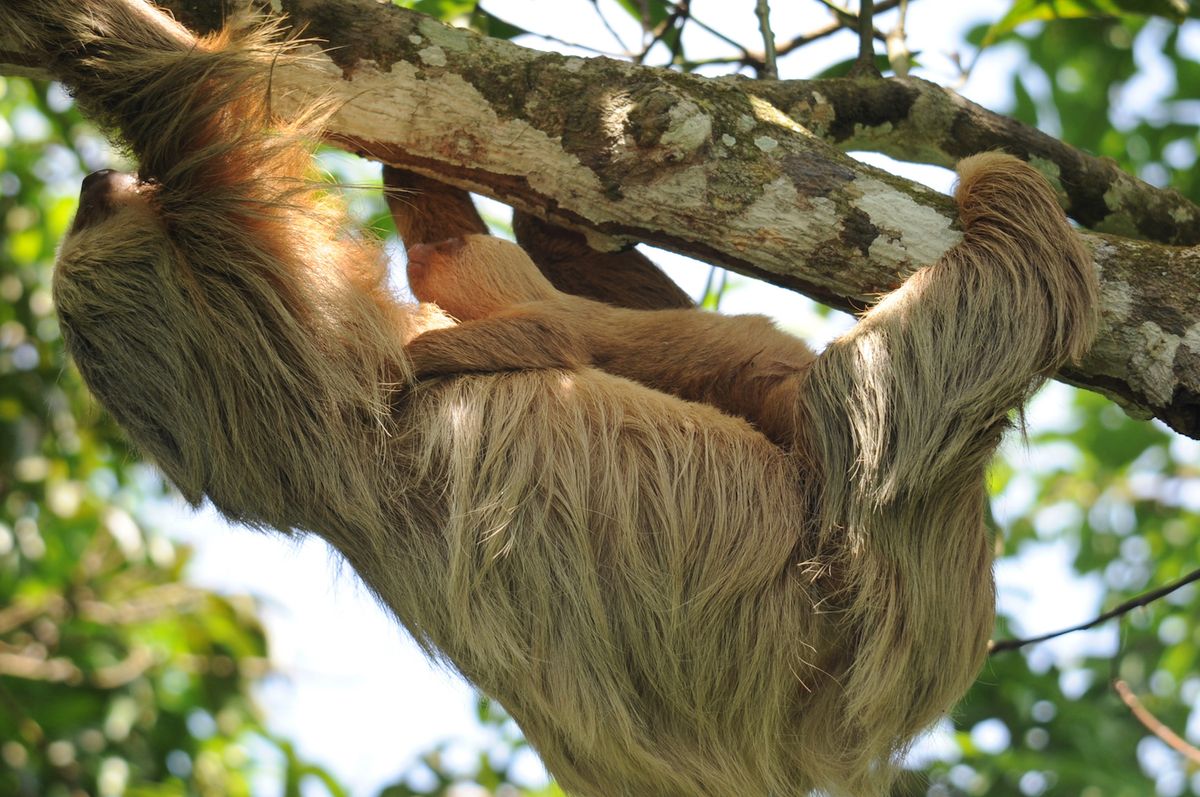How Sloths Reproduce
Have you ever seen a sloth? Ever wondered why are sloths slow? Since we moved to Costa Rica, I’ve learned a bunch of funny sloth facts that have made me LOL… oh ya, and learn a bunch, too. These animals are so impressive and have evolved from the size of elephants!
These 50 sloth facts for kids answer questions like why are sloths slow, what do sloths eat, even how you can adopt a sloth to help protect them and their habitat. Read on for fun facts about sloths and share them with your friends! We have lots to learn about these adorable creatures, including how to breathe while hanging upside down all day!
The pygmy three-toed sloth (Bradypus pygmaeus), also known as the monk sloth or dwarf sloth, is a sloth endemic to Isla Escudo de Veraguas, a small island off the coast of Panama.The species was first described by Robert P. Anderson of the University of Kansas and Charles O. Handley Jr., of the Smithsonian Institution in 2001. The pygmy three-toed sloth is significantly. The females and males live together in the same tree, during breeding time. Female sloths, often live together, while the male sloths are observed dwelling in different trees. Reproduction The pale- and brown-throated three-toed sloths mate seasonally, while the maned three-toed sloth breeds at any time of the year. The reproduction of pygmy three-toed sloths is unknown. Litters are of one newborn only, after six months' gestation for three-toed, and 12 months' for two-toed. The sloth skeleton is suited for reclining or hanging upside down in trees. That's how sloths eat, sleep, give birth—and mate. Though the rain forest exhibit at Baltimore's National Aquarium has.
Funny Sloth Facts
Did you know that sloths can NOT walk?! They actually can move up to three times faster when they swim vs on land, which isn’t saying much.
Speaking of sloths swimming, sloths can hold their breath for an impressive 40 minutes.
The modern sloth is usually around the size of a medium-sized dog, but did you know….
Ancient sloths of years ago, known as Megatherium, could grow as large as an Asian elephant!
Sloths have extra vertebrae at the base of their neck that allows them to turn their head on a 270°.
Sloths obtain an almost 360° view of their surroundings, which proves to be a highly beneficial defensive mechanism and super duper funny!
BABY SLOTHS!!!! Sloths try to reproduce once a year but sometimes don’t have enough energy to find a partner! How hilarious is that?!
The mommy sloth is pregnant for 11.5 months. That is longer than a human!
The mom sloth gives birth to only one baby at a time, just like most of our moms do.
When a mom gives birth, her job is not done yet! The baby sloth clings on to her mother for a few weeks and stays by her side for about four years.
Fun Facts about Sloths
Why do sloths move so slow?! The sloth’s body allows it to conserve energy, moving slower than any animal on the planet!
Sloths usually travel no more than 125 feet (38 meters) in a single day, and on the rare occasion that they find themselves at ground level (when they poop! See below…), they crawl only 1 foot (30 cm) per minute.
Sloths can move very fast when being threatened or hunted about 2 meters per min. Or 3 meters on the ground level per min.
Sloths poop once a week which makes them have serious constipation sometimes!

Sloths have to go so on the ground to make their poop dreams happen, making them an easy target for a predator.
When a sloth goes down on ground level they do a ‘poo dance’ and dig a small hole to put their treasures in. I’ve seen it happen and it is as funny as you think it is!
The facial structure of a sloth gives the appearance that it is constantly smiling, which is why we’re all obsessed with them! But their face looks like its smiling even if it is experiencing pain, stress or anxiety!
When sloths are used as a photo prop for wildlife selfies, tourists may accidentally confuse this feature for happiness or contentment and cause undue stress to the animal. Actually, in 2019, Costa Rica launched a campaign discouraging tourists from taking “cruel or inappropriate selfies” with animals. Learn more about Costa Rica’s initiative here.
Though captive sloths have been known to sleep 15 to 20 hours a day, wild sloths will usually only snooze for 10 hours.
Where Do Sloths Live?
Wild sloths live in trees most of their lives, but sloths are actually among the best-adapted creatures in the rainforest of Central and South America. Though they’ve adopted for tree-hugging life, sometimes sloths fall out of trees too!
Sloths are built perfectly for life in the trees because of their adaptive traits, such as arms that are longer than their legs and curved feet for grasping branches and specialized claws for hooking on, as well as flexible bone structure allowing for flexibility.
A sloth’s fur actually serves as a self-contained ecological community supporting colonies of moths and algae. Like every sloth is carrying around a little world of their own!

Recently, scientists took samples of fungus from sloth hairs and found that some were adept at fighting parasites, bacteria and even human cancer cells!
How Do Sloths Communicate
Why Are Sloth Slow?
Sloth Diet
The sloth diet is super healthy! So what do sloth eat, exactly? Sloths are herbivores meaning they do not eat other animals – just lots of flower buds, leafy, green stuff and tender shoots of trees. You know, the stuff our parents are always telling us to eat!
Sloths have a multi-compartment stomach (like FOUR parts!) that allows them to effectively digest the tough cellulose vegetation they eat.
Sloths take over 30 days to digest one leaf! Talk about taking your time…
Do you mix up your food to hide the stuff you don’t like? The sloth diet has been known to consist of insects and birds to supplement their diet… and hide the taste of all those leafy greens, I’m sure!
Sloth Eating
When a sloth is eating, it is absolutely adorable but it’s not easy living on sticks and leaves. To maintain their strict sloth diet, these mammals keep a body temperature of 30-34 degrees celsius, and even lower when they are asleep, to have enough energy to eat their dinner.
Do you think that a sloth eating poison ivy would hurt them? The answer is NO! But it actually can hurt the sloth predators! Better think twice before making a sloth your lunch.
Sloths don’t smell! They look like they could keep some stink in that fur, but they do not give off any sort of body odor as a way of staying camouflaged. And to keep out of the way of predators.
Do Sloth Have Predators?
Do sloths have predators? Yes, they do but they are very well adapted. They have a slow metabolism and help them to safely digest their food.
Sloth enemies are scary for this slow animal! While sloths don’t have many predators, sloth predators are harpy eagles, jaguars and anaconda snakes.
Sloths can retain their grip after death making it super hard for predators to take their lunch to-go.
Sloth Predators
Sloths have a beneficial relationship with the algae that grows on their fur. While the sloth provides the algae with shelter and water and the algae provides camouflage and nutrients to best hide from sloth predators.
Truth be told, sloths do have teeth… just not very many! Sloths have only 10 upper teeth and 8 lower teeth.
Sloths are so well adapted that despite being slow, they thrive in their habitats. Sloths are built perfectly for life in the trees with their long arms and mega-sharp nails! Not many predators dare to mess with them because of their various defensive tricks.
Sloth Enemies
Sloth Hands + Claws
Sloth hands are pretty amazing and highly adapted for the species success. Sloth hands and feet have long, curved claws to allow them to hang upside down from branches without effort.
Sloth claws are super strong and not just for hanging around in treetops! Sloth claws are also used to drag themselves along the ground since they can’t walk.
The sloth has impressive biology which allows it to spend 90% of its life hanging upside down. Unlike you and me, this perpetual state of hanging out has no effect on a sloth’s breathing.
Breathing is easier while upside down because their organs are attached to their rib cage, which means they don’t weigh down on the lungs.
Two Toed Sloth
There are two different types of sloths: the two-toed sloth and three-toed sloths. Contrary to popular belief, all sloths have 3 toes but two toed sloths have 2 fingers!
There are six species: pygmy three-toed sloth, the maned sloth, the pale throated sloth, brown-throated sloth, and the Linnaeus’s two-toed sloth.
Sloths these days live in Central and South America…. which is where I live now! You can find them out in the wild and in rescue centers all throughout Central and South America.
Sloths live up to 30 years!
Sloths have small ears and do not hear well but have excellent smells and other senses.
How Often Do Sloths Mate
Modern-day sloths may not look cute and cuddly, but go back a bunch of years and you’ll encounter something very menacing or even dangerous! If their ancestors caught you, they could make you wish for a quick and swift death.
Sloths are one of the slowest animals on the face of the earth, but they are also one of the smartest animals. They are funny, cute and very noisy .
Sloth Facts for Kids
Sloth Adoption
Now that you’ve fallen in love with these amazing animal and learned about what do sloths eat, why are they slow and even how they go poop, you might be wondering what you can do to make sure they never go extinct or endangered? I’m so glad you asked!
Instead of asking for yet another Lego set, how about asking for the gift of a sloth adoption! By supporting sloth care and preserving their natural habitat, you can impact the world! We’ve checked out The Sloth Institute and love their Adopt A Sloth project that helps raise funds for the care and protection of these amazing creatures. Check them out!
Animal Facts for Kids!
Learn more about the amazing animals in our world with these random animal facts for kids.

Our editors will review what you’ve submitted and determine whether to revise the article.
Join Britannica's Publishing Partner Program and our community of experts to gain a global audience for your work!Sloth, (suborder Phyllophaga), tree-dwelling mammal noted for its slowness of movement. All five living species are limited to the lowland tropical forests of South and Central America, where they can be found high in the forest canopy sunning, resting, or feeding on leaves. Although two-toed sloths (family Megalonychidae) are capable of climbing and positioning themselves vertically, they spend almost all of their time hanging horizontally, using their large hooklike extremities to move along branches and vines. Three-toed sloths (family Bradypodidae) move in the same way but often sit in the forks of trees rather than hanging from branches.
What kind of animal is a sloth?
Sloths are mammals. They are part of the order Pilosa, which is also home to anteaters. Together with armadillos, sloths and anteaters form the magnorder Xenarthra.
How many types of sloths are there?
A total of five species of sloths exist: the pygmy three-toed sloth, the maned sloth, the pale-throated three-toed sloth, the brown-throated three-toed sloth, and Linnaeus's two-toed sloth. All sloths are either two-toed or three-toed.
Where do sloths live?
Sloths live in the lowland tropical areas of South and Central America. They spend most of their life in the forest canopy. Two-toed sloths tend to hang horizontally from branches, while three-toed sloths often sit in the forks of trees.
What do sloths eat?
Sloths are omnivores. Because they spend most of their time in trees, they like to munch on leaves, twigs, flowers, and other foliage, though some species may eat insects and other small animals.
Why are sloths so slow?
Sloths are slow because of their diet and metabolic rate. They eat a low-calorie diet consisting exclusively of plants, and they metabolize at a rate that is only 40–45 percent of what is expected for mammals of their weight. Sloths must move slowly to conserve energy.
Sloths have long legs, stumpy tails, and rounded heads with inconspicuous ears. Although they possess colour vision, sloths’ eyesight and hearing are not very acute; orientation is mainly by touch. The limbs are adapted for suspending the body rather than supporting it. As a result, sloths are completely helpless on the ground unless there is something to grasp. Even then, they are able only to drag themselves along with their claws. They are surprisingly good swimmers. Generally nocturnal, sloths are solitary and are aggressive toward others of the same sex.
Sloths have large multichambered stomachs and an ability to tolerate strong chemicals from the foliage they eat. The leafy food is digested slowly; a fermenting meal may take up to a week to process. The stomach is constantly filled, its contents making up about 30 percent of the sloth’s weight. Sloths descend to the ground at approximately six-day intervals to urinate and defecate (see Sidebar: A moving habitat). Physiologically, sloths are heterothermic—that is, they have imperfect control over their body temperature. Normally ranging between 25 and 35 °C (77 and 95 °F), body temperature may drop to as low as 20 °C (68 °F). At this temperature the animals become torpid. Although heterothermicity makes sloths very sensitive to temperature change, they have thick skin and are able to withstand severe injuries.
All sloths were formerly classified in the same family (Bradypodidae), but two-toed sloths have been found to be so different from three-toed sloths that they are now classified in a separate family (Megalonychidae).
How Do Sloths Reproduce
Three-toed sloths
The three-toed sloth (family Bradypodidae) is also called the ai in Latin America because of the high-pitched cry it produces when agitated. All four species belong to the same genus, Bradypus, and the coloration of their short facial hair bestows them with a perpetually smiling expression. The brown-throated three-toed sloth (B. variegatus) occurs in Central and South America from Honduras to northern Argentina; the pale-throated three-toed sloth (B. tridactylus) is found in northern South America; the maned sloth (B. torquatus) is restricted to the small Atlantic forest of southeastern Brazil; and the pygmy three-toed sloth (B. pygmaeus) inhabits the Isla Escudo de Veraguas, a small Caribbean island off the northwestern coast of Panama.
Although most mammals have seven neck vertebrae, three-toed sloths have eight or nine, which permits them to turn their heads through a 270° arc. The teeth are simple pegs, and the upper front pair are smaller than the others; incisor and true canine teeth are lacking. Adults weigh only about 4 kg (8.8 pounds), and the young weigh less than 1 kg (2.2 pounds), possibly as little as 150–250 grams (about 5–9 ounces) at birth. (The birth weight of B. torquatus, for example, is only 300 grams [about 11 ounces].) The head and body length of three-toed sloths averages 58 cm (23 inches), and the tail is short, round, and movable. The forelimbs are 50 percent longer than the hind limbs; all four feet have three long, curved sharp claws. Sloths’ coloration makes them difficult to spot, even though they are very common in some areas. The outer layer of shaggy long hair is pale brown to gray and covers a short, dense coat of black-and-white underfur. The outer hairs have many cracks, perhaps caused by the algae living there. The algae give the animals a greenish tinge, especially during the rainy season. Sexes look alike in the maned sloth, but in the other species males have a large patch (speculum) in the middle of the back that lacks overhair, thus revealing the black dorsal stripe and bordering white underfur, which is sometimes stained yellow to orange. The maned sloth gets its name from the long black hair on the back of its head and neck.
Three-toed sloths, although mainly nocturnal, may be active day or night but spend only about 10 percent of their time moving at all. They sleep either perched in the fork of a tree or hanging from a branch, with all four feet bunched together and the head tucked in on the chest. In this posture the sloth resembles a clump of dead leaves, so inconspicuous that it was once thought these animals ate only the leaves of cecropia trees because in other trees it went undetected. Research has since shown that they eat the foliage of a wide variety of other trees and vines. Locating food by touch and smell, the sloth feeds by hooking a branch with its claws and pulling it to its mouth. Sloths’ slow movements and mainly nocturnal habits generally do not attract the attention of predators such as jaguars and harpy eagles. Normally, three-toed sloths are silent and docile, but if disturbed they can strike out furiously with the sharp foreclaws.
Reproduction is seasonal in the brown- and pale-throated species; the maned sloth may breed throughout the year. Reproduction in pygmy three-toed sloths, however, has not yet been observed. A single young is born after less than six months’ gestation. Newborn sloths cling to the mother’s abdomen and remain with the mother until at least five months of age. Three-toed sloths are so difficult to maintain in captivity that little is known about their breeding behaviour and other aspects of their life history.
How Fast Do Sloths Reproduce

Sloth Mating
- related topics